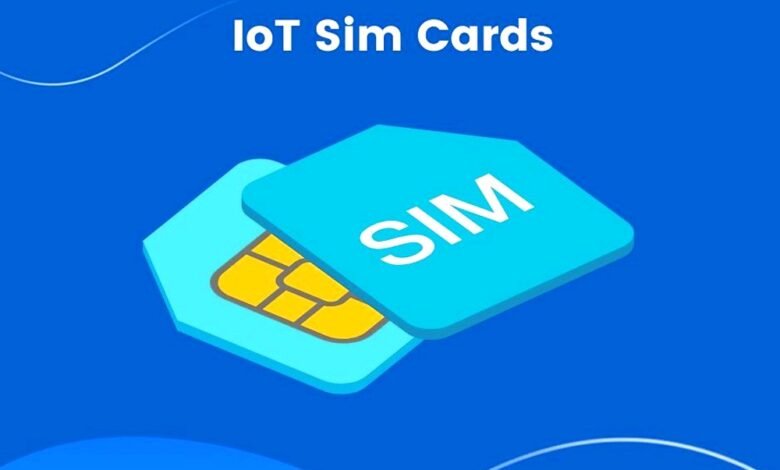What is an IoT Sim Cards and How does it Work?
In this article, we will explore everything you need to know about IoT SIM cards, their applications, and why they are becoming essential in the world of IoT.

In today’s connected world, the Internet of Things (IoT) is revolutionising how devices communicate. From smart cities to self-driving cars, IoT SIM cards are playing a crucial role in enabling connectivity across a wide array of industries. But what exactly is an IoT SIM card, and how does it work?
In this article, we will explore everything you need to know about IoT SIM cards, their applications, and why they are becoming essential in the world of IoT.
What is an IoT SIM Card?
An IoT SIM card is a specialised SIM card designed to connect IoT devices to a cellular network. Unlike traditional SIM cards used in smartphones, IoT SIM cards are optimised for machine-to-machine (M2M) communication. They allow devices like sensors, meters, and vehicles to send and receive data over the internet with minimal human intervention. This small card is what powers the connected world, providing the lifeline for devices to talk to each other.
How Does an IoT SIM Card Work?
Much like regular SIM cards, IoT SIM cards work by connecting a device to a mobile network. However, IoT SIMs often come with features like multi-network roaming, global coverage, and remote provisioning, making them more versatile for devices that need to operate in different regions or environments. When an IoT device is turned on, the SIM card enables it to connect to a network, allowing it to transmit and receive data. This seamless communication is what enables IoT devices to function autonomously.
Key Features of IoT SIM Cards
IoT SIM cards come packed with features that make them ideal for connecting devices across the globe. Some of the key features include:
- Global Coverage: IoT SIM cards often support multiple networks, ensuring connectivity anywhere in the world.
- Remote Management: IoT SIMs can be managed remotely, allowing updates and diagnostics without physically accessing the device.
- Security: These cards are equipped with enhanced security features to protect against cyber threats and unauthorised access.
- Durability: Built to withstand extreme temperatures and environments, IoT SIM cards are designed for industrial use.
Types of IoT SIM Cards

There are several types of IoT SIM cards to suit different needs:
- Standard IoT SIM: Similar to regular SIM cards but with enhanced features for M2M communication.
- eSIM: embedded SIMs that can be programmed remotely, eliminating the need for physical cards.
- Multi-network SIM: These cards can switch between multiple networks to ensure the best possible connection.
Each type of SIM has its own unique advantages, depending on the use case and region where it is deployed.
IoT SIM Cards vs. Traditional SIM Cards
While traditional SIM cards are primarily used for personal communication, IoT SIM cards are optimised for connecting machines. Regular SIM cards prioritise voice and data for human users, whereas IoT SIM cards focus on low-power, long-range communication for devices. Another key difference is that IoT SIMs offer more robust security features and can switch between networks to maintain a stable connection in various regions.
Related: What is the Difference between IoT SIMs and Phone SIMs?
Benefits of Using IoT SIM Cards
IoT SIM cards offer numerous benefits, making them indispensable for businesses:
- Seamless Connectivity: With global roaming and multi-network support, IoT devices can stay connected wherever they are.
- Cost-Efficient: By using low-power networks, IoT SIM cards help reduce data costs, especially for devices that only need to transmit small amounts of data.
- Scalability: IoT SIMs allow businesses to scale their IoT deployments easily, adding new devices with minimal effort.
- Reliability: The ability to switch between networks ensures reliable connectivity, crucial for mission-critical applications like healthcare and transportation.
Applications of IoT SIM Cards

IoT SIM cards are used in a wide variety of applications:
- Healthcare: Medical devices use IoT SIMs to monitor patients remotely and transmit health data to doctors in real-time.
- Smart Cities: IoT SIM cards power sensors and systems that manage traffic, energy consumption, and public services in urban areas.
- Agriculture: IoT SIMs enable smart farming tools, such as automated irrigation systems, to enhance crop production.
- Retail: Point-of-sale (POS) systems rely on IoT SIMs to process payments and manage inventory in real-time.
The use cases are endless, with IoT SIMs connecting devices across industries, creating smarter and more efficient systems.
IoT SIM Cards in Smart Cities
Smart cities rely heavily on IoT SIM cards to manage infrastructure. From monitoring air quality to controlling streetlights, IoT SIM cards make it possible for city systems to operate intelligently. Traffic management, for example, uses IoT SIM cards to adjust signal timing in real-time, reducing congestion and improving traffic flow. As cities become more connected, the role of IoT SIM cards will continue to grow.
IoT SIM Cards for Fleet Management
Fleet managers use IoT SIM cards to track vehicles, monitor performance, and improve logistics. By embedding IoT SIMs in vehicles, companies can get real-time data on location, fuel consumption, and driver behaviour. This helps optimise routes, reduce fuel costs, and ensure timely deliveries. The ability to track every vehicle in a fleet from a central location has revolutionised fleet management.
Security Concerns and Solutions
With increased connectivity comes the risk of security breaches. IoT devices can be vulnerable to cyberattacks, especially when handling sensitive data. IoT SIM cards address these concerns by offering encryption, two-factor authentication, and secure network connections. Additionally, IoT SIMs allow for remote monitoring, making it easier to detect and prevent unauthorised access to devices.
Choosing the Right IoT SIM Card Provider
When selecting an IoT SIM card provider, several factors should be considered:
- Global coverage: ensure the provider offers coverage in all regions where your devices will be deployed.
- Pricing: Look for transparent pricing models with no hidden fees for data usage.
- Support: Choose a provider that offers 24/7 customer support to resolve issues quickly.
- Security: Verify that the provider offers robust security measures to protect your devices and data.
The right provider can make all the difference in the success of your IoT project.
Cost Considerations
The cost of IoT SIM cards varies depending on factors such as data usage, global coverage, and the number of devices. Some providers offer flexible pricing plans that allow businesses to pay based on actual usage, while others may charge a flat fee per device. When planning an IoT deployment, it’s important to consider both upfront costs and ongoing expenses to ensure the project remains cost-effective.
Future of IoT SIM Cards
As IoT technology continues to evolve, IoT SIM cards are expected to become even more powerful. Future developments may include increased data speeds, enhanced security features, and more advanced network management capabilities. Additionally, the adoption of 5G networks will further enhance the capabilities of IoT SIM cards, allowing for faster and more reliable connections between devices.
Conclusion
IoT SIM cards are the backbone of modern IoT systems, providing seamless connectivity for devices across the globe. From smart cities to healthcare, these cards are transforming industries and driving innovation. As IoT technology continues to grow, the role of IoT SIM cards will become even more significant, enabling the next generation of connected devices. Whether you’re looking to implement IoT in your business or city, choosing the right IoT SIM card is key to ensuring reliable and secure connectivity.











